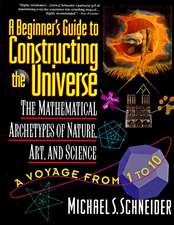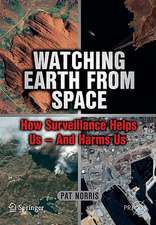Applied Photometry, Radiometry, and Measurements of Optical Losses: Springer Series in Optical Sciences, cartea 163
Autor Michael Bukshtaben Limba Engleză Paperback – 23 feb 2014
| Toate formatele și edițiile | Preț | Express |
|---|---|---|
| Paperback (1) | 969.99 lei 38-44 zile | |
| SPRINGER NETHERLANDS – 23 feb 2014 | 969.99 lei 38-44 zile | |
| Hardback (1) | 1405.09 lei 6-8 săpt. | |
| SPRINGER NETHERLANDS – 3 ian 2012 | 1405.09 lei 6-8 săpt. |
Din seria Springer Series in Optical Sciences
- 24%
 Preț: 945.47 lei
Preț: 945.47 lei - 18%
 Preț: 1850.21 lei
Preț: 1850.21 lei - 18%
 Preț: 2124.06 lei
Preț: 2124.06 lei - 20%
 Preț: 568.47 lei
Preț: 568.47 lei - 18%
 Preț: 1118.93 lei
Preț: 1118.93 lei - 18%
 Preț: 999.76 lei
Preț: 999.76 lei - 18%
 Preț: 957.62 lei
Preț: 957.62 lei - 18%
 Preț: 892.11 lei
Preț: 892.11 lei - 15%
 Preț: 648.56 lei
Preț: 648.56 lei - 18%
 Preț: 1838.07 lei
Preț: 1838.07 lei -
 Preț: 379.86 lei
Preț: 379.86 lei - 18%
 Preț: 1392.95 lei
Preț: 1392.95 lei - 18%
 Preț: 1232.89 lei
Preț: 1232.89 lei - 18%
 Preț: 1568.95 lei
Preț: 1568.95 lei - 18%
 Preț: 2095.49 lei
Preț: 2095.49 lei - 18%
 Preț: 1227.84 lei
Preț: 1227.84 lei - 15%
 Preț: 643.65 lei
Preț: 643.65 lei - 18%
 Preț: 954.45 lei
Preț: 954.45 lei - 18%
 Preț: 947.35 lei
Preț: 947.35 lei - 18%
 Preț: 1241.55 lei
Preț: 1241.55 lei - 18%
 Preț: 947.04 lei
Preț: 947.04 lei -
 Preț: 392.21 lei
Preț: 392.21 lei - 18%
 Preț: 997.53 lei
Preț: 997.53 lei - 18%
 Preț: 1562.31 lei
Preț: 1562.31 lei - 18%
 Preț: 1110.24 lei
Preț: 1110.24 lei - 15%
 Preț: 651.19 lei
Preț: 651.19 lei -
 Preț: 414.69 lei
Preț: 414.69 lei - 18%
 Preț: 952.57 lei
Preț: 952.57 lei - 15%
 Preț: 641.03 lei
Preț: 641.03 lei - 15%
 Preț: 635.80 lei
Preț: 635.80 lei
Preț: 969.99 lei
Preț vechi: 1276.30 lei
-24% Nou
Puncte Express: 1455
Preț estimativ în valută:
185.63€ • 193.09$ • 153.25£
185.63€ • 193.09$ • 153.25£
Carte tipărită la comandă
Livrare economică 10-16 aprilie
Preluare comenzi: 021 569.72.76
Specificații
ISBN-13: 9789401785266
ISBN-10: 9401785260
Pagini: 732
Dimensiuni: 155 x 235 x 38 mm
Greutate: 1 kg
Ediția:2012
Editura: SPRINGER NETHERLANDS
Colecția Springer
Seria Springer Series in Optical Sciences
Locul publicării:Dordrecht, Netherlands
ISBN-10: 9401785260
Pagini: 732
Dimensiuni: 155 x 235 x 38 mm
Greutate: 1 kg
Ediția:2012
Editura: SPRINGER NETHERLANDS
Colecția Springer
Seria Springer Series in Optical Sciences
Locul publicării:Dordrecht, Netherlands
Public țintă
ResearchCuprins
Acknowledgements.
Abstract.
Preface.
PART I APPLIED PHOTOMETRY AND RADIOMETRY. I.1. Background.
Chapter 1Radiometric and photometric quantities and notions. 1.1. Physical sense of radiometric conception. 1.2. Parameters of optical radiation. 1.3. Radiation interactions with material objects.
Chapter 2Methods of photometric and radiometric measurements. 2.1. Evaluation of power and energy extents of optical radiation. 2.2. Analysis of attenuation factors. 2.3. Measurements of color coordinates and indices. 2.4. Photometry of integrating spheres.
Chapter 3Radiometry of partially coherent radiation. 3.1. Coherence and radiative transfer. 3.2. Laser and pulsed light. 3.3. Interference phenomena and optical measurements. 3.4. Diffraction corrections and gratings in radiometry and photometry.
Chapter 4Photometers and radiometers. 4.1. Optical design and absolute calibration of radiometers. 4.2. Attenuation and color photometers and spectrophotometers. 4.3. Photometric accuracy and verification of linearity.
PART II MEASUREMENTS OF OPTICAL LOSSES. II.1. Features of low-loss assessments.
Chapter 5Conventional measurement techniques. 5.1. Internal transmittance and attenuation coefficient. 5.2. Specular reflectance. 5.3. Scattering factor.
Chapter 6Systems of multiple reflections. 6.1. Flat-mirror and prism reflector cells. 6.2. Multipass cavities. 6.3. Mirror waveguides. 6.4. Multiplication of Raman scattering. 6.5. Interference-fringe reduction in multipass and derivative spectroscopy.
Chapter 7Laser spectroscopy. 7.1. Active intracavity measurements. 7.2. Comparison of intracavity methods. 7.3. Intracavity and ringdown spectroscopy.
Chapter 8Measurements in passive resonators. 8.1. Pulse-separation techniques. 8.2. Interferometric analysis. 8.3. Resonant phase-shift and decay-time studies. 8.4. Quality-factor transfer method and asymmetric-cavity measurements. 8.5. Evaluation of loss-dichroism and phase-dispersion.
Chapter 9Determination of absorption losses. 9.1. Laser calorimetry. 9.2. Thermal-lensing, photothermal, and photoacoustic techniques. 9.3. Emissive spectroscopy. 9.4. Integrating spheres as multiple-reflection cavities.
Chapter 10Direct attenuation measurements. 10.1. Differential, ratio, and single-channel systems. 10.2. Derivative spectroscopy. 10.3. Wavelength tuning and balanced detection. 10.4. Separation of bulk and surface losses. 10.5. Reflection spectrophotometry.
Chapter 11Propagation losses in fibers and waveguides. 11.1. Measurements of internal optical attenuation for guided light. 11.2. Analysis of return losses via backscattered radiation. 11.3. Partition of distributed losses and attenuation factors in reflected light. 11.4. Interference noise and crosstalk in fiber transmission systems.
References.
PART I APPLIED PHOTOMETRY AND RADIOMETRY. I.1. Background.
Chapter 1Radiometric and photometric quantities and notions. 1.1. Physical sense of radiometric conception. 1.2. Parameters of optical radiation. 1.3. Radiation interactions with material objects.
Chapter 2Methods of photometric and radiometric measurements. 2.1. Evaluation of power and energy extents of optical radiation. 2.2. Analysis of attenuation factors. 2.3. Measurements of color coordinates and indices. 2.4. Photometry of integrating spheres.
Chapter 3Radiometry of partially coherent radiation. 3.1. Coherence and radiative transfer. 3.2. Laser and pulsed light. 3.3. Interference phenomena and optical measurements. 3.4. Diffraction corrections and gratings in radiometry and photometry.
Chapter 4Photometers and radiometers. 4.1. Optical design and absolute calibration of radiometers. 4.2. Attenuation and color photometers and spectrophotometers. 4.3. Photometric accuracy and verification of linearity.
PART II MEASUREMENTS OF OPTICAL LOSSES. II.1. Features of low-loss assessments.
Chapter 5Conventional measurement techniques. 5.1. Internal transmittance and attenuation coefficient. 5.2. Specular reflectance. 5.3. Scattering factor.
Chapter 6Systems of multiple reflections. 6.1. Flat-mirror and prism reflector cells. 6.2. Multipass cavities. 6.3. Mirror waveguides. 6.4. Multiplication of Raman scattering. 6.5. Interference-fringe reduction in multipass and derivative spectroscopy.
Chapter 7Laser spectroscopy. 7.1. Active intracavity measurements. 7.2. Comparison of intracavity methods. 7.3. Intracavity and ringdown spectroscopy.
Chapter 8Measurements in passive resonators. 8.1. Pulse-separation techniques. 8.2. Interferometric analysis. 8.3. Resonant phase-shift and decay-time studies. 8.4. Quality-factor transfer method and asymmetric-cavity measurements. 8.5. Evaluation of loss-dichroism and phase-dispersion.
Chapter 9Determination of absorption losses. 9.1. Laser calorimetry. 9.2. Thermal-lensing, photothermal, and photoacoustic techniques. 9.3. Emissive spectroscopy. 9.4. Integrating spheres as multiple-reflection cavities.
Chapter 10Direct attenuation measurements. 10.1. Differential, ratio, and single-channel systems. 10.2. Derivative spectroscopy. 10.3. Wavelength tuning and balanced detection. 10.4. Separation of bulk and surface losses. 10.5. Reflection spectrophotometry.
Chapter 11Propagation losses in fibers and waveguides. 11.1. Measurements of internal optical attenuation for guided light. 11.2. Analysis of return losses via backscattered radiation. 11.3. Partition of distributed losses and attenuation factors in reflected light. 11.4. Interference noise and crosstalk in fiber transmission systems.
References.
Notă biografică
Michael
A
Bukshtabreceived
M.S.
and
Ph.D.
degrees
in
“Optical
Design
and
Spectroscopy”
and
in
“Physical
Optics”
from
The
Technical
University
of
Fine
Mechanics
&
Optics
and
from
The
Vavilov’
State
Optical
Institute,
and
had
post-doctoral
tenure
analyzing
high-purity
silica
glasses
and
specialty
fibers
in
The
Institute
of
Silicate
Chemistry,
Academy
of
Sciences
-
all
in
St.
Petersburg
(Leningrad),
Russia.
His
M.S.
thesis
received
the
Best
Diploma
award
among
nearly
30
Leningrad
technical
universities
and
was
published
in
“Measurement
Techniques”
in
1978.
Michael’s
monograph
“The
Low
Loss
Measurement
Techniques”,
165
pages,
was
published
in
1988
by
Energoatomizdat,
Moscow-Leningrad.
Another
book:
M.A.
Bukshtab,
A.
S.
Doynikov,
and
V.
N.
Koromislichenko,
“Photometry
and
Radiometry
for
Engineers”
(editors
M.
A.
Bukshtab
and
A.
A.
Wolkenstein)
by
Polytechnika,
Leningrad
(St.
Petersburg),
1991,
was
announced
for
publication,
book
proofs
were
printed,
but
manuscript
was
left
unpublished,
as
Michael
immigrated
to
the
USA.
Michael
was
elected
by
employees
the
Board
Chairman
of
Leningrad’s
Institute
of
Telecommunications,
where
he
served
from
1989
until
immigrating
in
1991.
In
USA
Michael
worked
on
design,
development,
and
fabrication
of
optical
systems
and
components
for
such
companies
as
Sandoz,
Corning,
Pirelli,
Kodak,
CIENA,
Lucent,
and
GE
Advanced
Materials.
Michael
latest
experience
via
Michael
A
Bukshtab
Consulting
includes
designing
complex
systems
and
components
and
investigating
various
optical
properties
-measurement
of
color-shifting,
polarization-dependent,
backreflection,
backscattering
and
other
low-loss
related
phenomena,
designing
all-optical
wavelength-switching
and
cross-connect
systems
and
OADM
networks,
working
on
terabit
optical
routers
and
optical
backplanes,
investigating
EUV
lithography
systems,
interferometric
and
diffraction-based
positioning
sensors,
improving
fiber-laser
and
EDFA-based
air-to-ground
ranging
lidars.
Michael
has
authored
and
coauthored
more
than
30
Patents
or
Invention
Certificates
and
participated
in
more
than
70
Scientific
Publications
and
Conference
Presentations.
Textul de pe ultima copertă
Applied
Photometry,
Radiometry,
and
Measurements
of
Optical
Lossesreviews
and
analyzes
physical
concepts
of
radiation
transfer,
providing
quantitative
foundation
for
the
means
of
measurements
of
optical
losses,
which
affect
propagation
and
distribution
of
light
waves
in
various
media
and
in
diverse
optical
systems
and
components.
The
comprehensive
analysis
of
advanced
methodologies
for
low-loss
detection
is
outlined
in
comparison
with
the
classic
photometric
and
radiometric
observations,
having
a
broad
range
of
techniques
examined
and
summarized:
from
interferometric
and
calorimetric,
resonator
and
polarization,
phase-shift
and
ring-down
decay,
wavelength
and
frequency
modulation
to
pulse
separation
and
resonant,
acousto-optic
and
emissive
-
subsequently
compared
to
direct
and
balancing
methods
for
studying
free-space
and
polarization
optics,
fibers
and
waveguides.
The
material
is
focused
on
applying
optical
methods
and
procedures
for
evaluation
of
transparent,
reflecting,
scattering,
absorbing,
and
aggregated
objects,
and
for
determination
of
power
and
energy
parameters
of
radiation
and
color
properties
of
light.
Caracteristici
The
applied
photometry
and
radiometry
emphasizes
original
methods
and
techniques
for
measurements
of
parameters
and
characteristics
of
optical
radiation,
and
the
underlying
principles
of
photometry
and
radiometry
for
observation
and
registration
of
power
and
energy
extents
of
light
and
its
visual
perception,
and
for
determination
of
optical
properties
of
bodies
and
mediums
in
direct,
diffuse,
and
scattered
radiation,
propagating
via
solid-state
and
liquid
specimen,
gas
species,
birefringent
substances,
optical
fibers,
and
planar
waveguides
The analysis and presentation of the material is organized from the standpoint of fundamental properties of optical radiation, such as spectral coherence, observability, and energy transfer, to very practical considerations of designing and building optical systems, elements and devices for the optical measurements, alongside with latest results of experiments and cross-method comparisons in white light and in spectrally resolved, cw, pulsed, polarized, spontaneous and partially- coherent laser radiation
The material focuses on the principal methodologies for optical loss measurements, including in-depth analysis of the founding concepts and the measurement drawbacks, extending to the comparison of laser interference noise reduction techniques in a variety of applications, as well as applying diffraction corrections and studying the wavelength dispersion or verifying the photometric accuracy
The analysis and presentation of the material is organized from the standpoint of fundamental properties of optical radiation, such as spectral coherence, observability, and energy transfer, to very practical considerations of designing and building optical systems, elements and devices for the optical measurements, alongside with latest results of experiments and cross-method comparisons in white light and in spectrally resolved, cw, pulsed, polarized, spontaneous and partially- coherent laser radiation
The material focuses on the principal methodologies for optical loss measurements, including in-depth analysis of the founding concepts and the measurement drawbacks, extending to the comparison of laser interference noise reduction techniques in a variety of applications, as well as applying diffraction corrections and studying the wavelength dispersion or verifying the photometric accuracy
Descriere
Applied
Photometry,
Radiometry,
and
Measurements
of
Optical
Losses
reviews
and
analyzes
physical
concepts
of
radiation
transfer,
providing
a
quantitative
foundation
for
the
means
of
measurements
of
optical
losses,
which
affect
propagation
and
distribution
of
light
waves
in
various
media.







